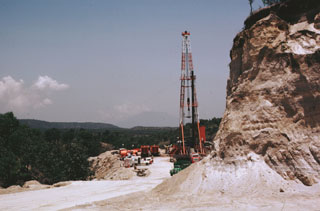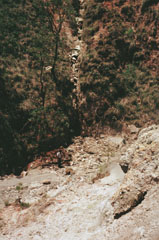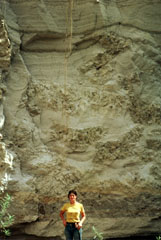

The Global Volcanism Program has no activity reports available for Sierra la Primavera.
The Global Volcanism Program has no Weekly Reports available for Sierra la Primavera.
The Global Volcanism Program has no Bulletin Reports available for Sierra la Primavera.
This compilation of synonyms and subsidiary features may not be comprehensive. Features are organized into four major categories: Cones, Craters, Domes, and Thermal Features. Synonyms of features appear indented below the primary name. In some cases additional feature type, elevation, or location details are provided.
Cones |
||||
| Feature Name | Feature Type | Elevation | Latitude | Longitude |
| Arroyo Saucillo | Vent | 20° 32' 0" N | 103° 33' 0" W | |
| Cañón de las Flores | Vent | 20° 42' 0" N | 103° 35' 0" W | |
| Llano Grande | Vent | 20° 35' 0" N | 103° 36' 0" W | |
| Planillas, Cerro las | Vent | 20° 35' 0" N | 103° 33' 0" W | |
| San Miguel, Cerro | Vent | 20° 36' 0" N | 103° 36' 0" W | |
| Tajo, Cerro el | Vent | 20° 36' 0" N | 103° 29' 0" W | |
Domes |
||||
| Feature Name | Feature Type | Elevation | Latitude | Longitude |
| Alto, Cerro | Dome | 20° 42' 0" N | 103° 32' 0" W | |
| Arroyo Colorado | Dome | 20° 35' 0" N | 103° 30' 0" W | |
| Arroyo Ixtahuatonte | Dome | 20° 38' 0" N | 103° 30' 0" W | |
| Arroyo La Cuartilla | Dome | 20° 43' 0" N | 103° 31' 0" W | |
| Arroyo las Animas | Dome | 20° 37' 0" N | 103° 35' 0" W | |
| Arroyo los Pilas | Dome | 20° 39' 0" N | 103° 29' 0" W | |
| Chapulín, Cerro el | Dome | 20° 41' 0" N | 103° 29' 0" W | |
| Chato, Cerro | Dome | 20° 42' 0" N | 103° 34' 0" W | |
| Colli, Cerro El | Dome | 20° 39' 0" N | 103° 28' 0" W | |
| Cuesta, Cerro La | Dome | 20° 37' 0" N | 103° 30' 0" W | |
| Culebreado, Cerro el | Dome | 20° 37' 0" N | 103° 33' 0" W | |
| Dos Coyotes | Dome | 20° 40' 0" N | 103° 29' 0" W | |
| Madrón, El | Dome | 20° 37' 0" N | 103° 31' 0" W | |
| Mesa el Burro | Dome | 20° 43' 0" N | 103° 35' 0" W | |
| Mesa el Chiquihuitillo | Dome | 20° 43' 0" N | 103° 36' 0" W | |
| Mesa el León | Dome | 20° 41' 0" N | 103° 36' 0" W | |
|
Mesa el Najahuete
Mesa el Majaguate |
Dome | 20° 40' 0" N | 103° 31' 0" W | |
| Mesa la Lobera | Dome | 20° 43' 0" N | 103° 30' 0" W | |
| Pedernal, Cerro el | Dome | 20° 40' 0" N | 103° 35' 0" W | |
| Pinar de la Venta | Dome | 20° 43' 0" N | 103° 32' 0" W | |
| Puerta, La | Dome | 20° 37' 0" N | 103° 35' 0" W | |
| Río Salado | Dome | 20° 41' 0" N | 103° 35' 0" W | |
| Tule, Cerro el | Dome | 20° 38' 0" N | 103° 32' 0" W | |
|
|
||||||||||||||||||
The Global Volcanism Program is not aware of any Holocene eruptions from Sierra la Primavera. If this volcano has had large eruptions (VEI >= 4) prior to 12,000 years ago, information might be found on the Sierra la Primavera page in the LaMEVE (Large Magnitude Explosive Volcanic Eruptions) database, a part of the Volcano Global Risk Identification and Analysis Project (VOGRIPA).
There is no Deformation History data available for Sierra la Primavera.
There is no Emissions History data available for Sierra la Primavera.
 The Sierra La Primavera complex has been the site of extensive geothermal development. The drill rig here is at well PR-5, located near the center of the caldera just south of the Mesa El Nejahuete lava dome. Surface exposures in this location consist of tephra-rich lacustrine sediments.
The Sierra La Primavera complex has been the site of extensive geothermal development. The drill rig here is at well PR-5, located near the center of the caldera just south of the Mesa El Nejahuete lava dome. Surface exposures in this location consist of tephra-rich lacustrine sediments. Steam rises from fumaroles (foreground) of the La Primavera geothermal field along La Azufrera fault, which can be seen in the vertical rock-filled gully in the background. Note the person observing the fault for scale. The geothermal field at La Primavera has been explored by the Mexican Comisión Federal de Electricidad (CFE) and exploratory drilling began in 1980.
Steam rises from fumaroles (foreground) of the La Primavera geothermal field along La Azufrera fault, which can be seen in the vertical rock-filled gully in the background. Note the person observing the fault for scale. The geothermal field at La Primavera has been explored by the Mexican Comisión Federal de Electricidad (CFE) and exploratory drilling began in 1980. The small Cerro El Colli lava dome is the easternmost of several emplaced along the Sierra La Primavera volcanic complex eastern caldera rim. Eruption of the Southern Arc lavas began about 60,000 years ago and were accompanied by eruptions of airfall pumice and pyroclastic flows. Southern Arc lavas are generally younger to the east.
The small Cerro El Colli lava dome is the easternmost of several emplaced along the Sierra La Primavera volcanic complex eastern caldera rim. Eruption of the Southern Arc lavas began about 60,000 years ago and were accompanied by eruptions of airfall pumice and pyroclastic flows. Southern Arc lavas are generally younger to the east. The giant pumice beds at Primavera volcano represent an unusual sedimentation event following formation of La Primavera caldera. Individual pumice blocks from 0.3 to more than 6 m across are enclosed within fine-grained volcanic ash-rich lake sediments. The giant pumice blocks originated by eruption of rhyolitic lava into a caldera lake. The pumice fractured into large blocks that floated to the surface, rafted across the lake, and settled to the bottom after becoming waterlogged. Subsequent deposition of fine-grained lake sediments buried the pumice blocks.
The giant pumice beds at Primavera volcano represent an unusual sedimentation event following formation of La Primavera caldera. Individual pumice blocks from 0.3 to more than 6 m across are enclosed within fine-grained volcanic ash-rich lake sediments. The giant pumice blocks originated by eruption of rhyolitic lava into a caldera lake. The pumice fractured into large blocks that floated to the surface, rafted across the lake, and settled to the bottom after becoming waterlogged. Subsequent deposition of fine-grained lake sediments buried the pumice blocks. The small Cerro El Colli is one of the youngest post-caldera domes of the Sierra La Primavera volcanic complex, immediately west of the city of Guadalajara. The dome, seen here from the south, has been dated to about 30,000 years and is the easternmost of several emplaced near the southern caldera rim. An 11-km-wide caldera formed as a result of the eruption of the 20 km3 Tala Tuff about 95,000 years ago. Fumaroles and hot springs are active throughout the volcanic complex.
The small Cerro El Colli is one of the youngest post-caldera domes of the Sierra La Primavera volcanic complex, immediately west of the city of Guadalajara. The dome, seen here from the south, has been dated to about 30,000 years and is the easternmost of several emplaced near the southern caldera rim. An 11-km-wide caldera formed as a result of the eruption of the 20 km3 Tala Tuff about 95,000 years ago. Fumaroles and hot springs are active throughout the volcanic complex.Maps are not currently available due to technical issues.
The following 25 samples associated with this volcano can be found in the Smithsonian's NMNH Department of Mineral Sciences collections, and may be availble for research (contact the Rock and Ore Collections Manager). Catalog number links will open a window with more information.
| Catalog Number | Sample Description | Lava Source | Collection Date |
|---|---|---|---|
| NMNH 117551-16 | Unidentified | -- | -- |
| NMNH 117551-17 | Unidentified | -- | -- |
| NMNH 117551-18 | Unidentified | -- | -- |
| NMNH 117551-19 | Unidentified | -- | -- |
| NMNH 117551-20 | Unidentified | -- | -- |
| NMNH 117551-21 | Unidentified | -- | -- |
| NMNH 117551-22 | Unidentified | -- | -- |
| NMNH 117551-23 | Unidentified | -- | -- |
| NMNH 117551-24 | Unidentified | -- | -- |
| NMNH 117551-25 | Unidentified | -- | -- |
| NMNH 117551-26 | Unidentified | -- | -- |
| NMNH 117551-27 | Unidentified | -- | -- |
| NMNH 117551-28 | Unidentified | -- | -- |
| NMNH 117551-29 | Unidentified | -- | -- |
| NMNH 117551-30 | Unidentified | -- | -- |
| NMNH 117551-31 | Unidentified | -- | -- |
| NMNH 117551-32 | Unidentified | -- | -- |
| NMNH 117551-33 | Unidentified | -- | -- |
| NMNH 117551-34 | Unidentified | -- | -- |
| NMNH 117551-35 | Unidentified | -- | -- |
| NMNH 117551-36 | Unidentified | -- | -- |
| NMNH 117551-37 | Unidentified | -- | -- |
| NMNH 117551-38 | Unidentified | -- | -- |
| NMNH 117551-39 | Unidentified | -- | -- |
| NMNH 117551-40 | Unidentified | -- | -- |
| Copernicus Browser | The Copernicus Browser replaced the Sentinel Hub Playground browser in 2023, to provide access to Earth observation archives from the Copernicus Data Space Ecosystem, the main distribution platform for data from the EU Copernicus missions. |
|
WOVOdat
Single Volcano View Temporal Evolution of Unrest Side by Side Volcanoes |
WOVOdat is a database of volcanic unrest; instrumentally and visually recorded changes in seismicity, ground deformation, gas emission, and other parameters from their normal baselines. It is sponsored by the World Organization of Volcano Observatories (WOVO) and presently hosted at the Earth Observatory of Singapore.
GVMID Data on Volcano Monitoring Infrastructure The Global Volcano Monitoring Infrastructure Database GVMID, is aimed at documenting and improving capabilities of volcano monitoring from the ground and space. GVMID should provide a snapshot and baseline view of the techniques and instrumentation that are in place at various volcanoes, which can be use by volcano observatories as reference to setup new monitoring system or improving networks at a specific volcano. These data will allow identification of what monitoring gaps exist, which can be then targeted by remote sensing infrastructure and future instrument deployments. |
| IRIS seismic stations/networks | Incorporated Research Institutions for Seismology (IRIS) Data Services map showing the location of seismic stations from all available networks (permanent or temporary) within a radius of 0.18° (about 20 km at mid-latitudes) from the given location of Sierra la Primavera. Users can customize a variety of filters and options in the left panel. Note that if there are no stations are known the map will default to show the entire world with a "No data matched request" error notice. |
| UNAVCO GPS/GNSS stations | Geodetic Data Services map from UNAVCO showing the location of GPS/GNSS stations from all available networks (permanent or temporary) within a radius of 20 km from the given location of Sierra la Primavera. Users can customize the data search based on station or network names, location, and time window. Requires Adobe Flash Player. |
| Large Eruptions of Sierra la Primavera | Information about large Quaternary eruptions (VEI >= 4) is cataloged in the Large Magnitude Explosive Volcanic Eruptions (LaMEVE) database of the Volcano Global Risk Identification and Analysis Project (VOGRIPA). |
| EarthChem | EarthChem develops and maintains databases, software, and services that support the preservation, discovery, access and analysis of geochemical data, and facilitate their integration with the broad array of other available earth science parameters. EarthChem is operated by a joint team of disciplinary scientists, data scientists, data managers and information technology developers who are part of the NSF-funded data facility Integrated Earth Data Applications (IEDA). IEDA is a collaborative effort of EarthChem and the Marine Geoscience Data System (MGDS). |